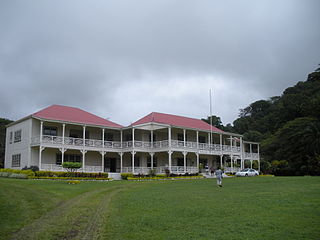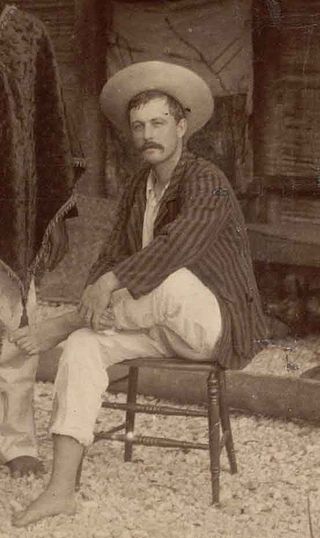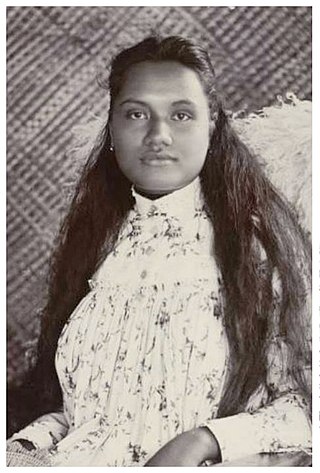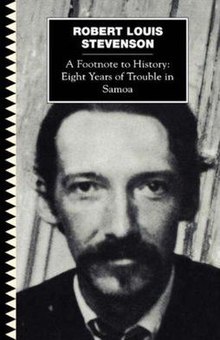
Robert Louis Stevenson was a Scottish novelist, essayist, poet and travel writer. He is best known for works such as Treasure Island, Strange Case of Dr Jekyll and Mr Hyde, Kidnapped and A Child's Garden of Verses.

Samoa, officially the Independent State of Samoa and until 1997 known as Western Samoa, is a Polynesian island country consisting of two main islands ; two smaller, inhabited islands ; and several smaller, uninhabited islands, including the Aleipata Islands. Samoa is located 64 km (40 mi) west of American Samoa, 889 km (552 mi) northeast of Tonga, 1,152 km (716 mi) northeast of Fiji, 483 km (300 mi) east of Wallis and Futuna, 1,151 km (715 mi) southeast of Tuvalu, 519 km (322 mi) south of Tokelau, 4,190 km (2,600 mi) southwest of Hawaii, and 610 km (380 mi) northwest of Niue. The capital and largest city is Apia. The Lapita people discovered and settled the Samoan Islands around 3,500 years ago. They developed a Samoan language and Samoan cultural identity.

The Samoan Islands were first settled some 3,500 years ago as part of the Austronesian expansion. Both Samoa's early history and its more recent history are strongly connected to the histories of Tonga and Fiji, nearby islands with which Samoa has long had genealogical links as well as shared cultural traditions.

Apia is the capital and only city of Samoa. It is located on the central north coast of Upolu, Samoa's second-largest island. Apia falls within the political district (itūmālō) of Tuamasaga.

Henry Clay Ide was a U.S. judge, colonial commissioner, ambassador, and Governor-General of the Philippines.

Sir Sidney Colvin was a British curator and literary and art critic, part of the illustrious Anglo-Indian Colvin family. He is primarily remembered for his friendship with Robert Louis Stevenson.

The Idler was an illustrated monthly magazine published in Great Britain from 1892 to 1911. It was founded by the author Robert Barr, who brought in the humorist Jerome K. Jerome as co-editor, and its contributors included many of the leading writers and illustrators of the time.
The turbulent decades of the late 19th century saw several conflicts between rival Samoan factions in the Samoan Islands of the South Pacific. The political struggle lasted roughly between 1886 and 1894, primarily between Samoans contesting whether Malietoa Laupepa, Mata'afa Iosefo, or a member of the Tupua Tamasese dynasty would be King of Samoa. While largely a political struggle, there were also armed skirmishes between the factions. The military of the German Empire intervened on several occasions. A naval standoff between the United States, Germany, and the United Kingdom ensued.

The 1889 Apia cyclone was a tropical cyclone in the South Pacific Ocean, which swept across Apia, Samoa on March 15, 1889, during the Samoan crisis. The effect on shipping in the harbour was devastating, largely because of what has been described as "an error of judgement that will forever remain a paradox in human psychology".

Vailima is the name of a village about four miles south of Apia, the capital of Samoa, the island nation in the Pacific Ocean. The population is 769. Vailima is part of the electoral political district Tuamasaga.

William Pritchard Coe (1857-1909) briefly served as Governor of Guam during 1899. He served in this position for two weeks. Previously Coe had lived in Samoa. Coe was the son of the American merchant and Consul Jonas Mynderse Coe who was born February 12, 1823, in Troy, New York and his first wife, Le'uta Malietoa born in Salesatele, Samoa the daughter of a chief.

Joseph Dwight Strong, Jr. (1853–1899) was an American artist and illustrator, known for his paintings. He was active between 1870s until 1899, in the San Francisco Bay Area, Monterey, Kingdom of Hawaii, and Samoa.
"The Beach of Falesá" is a novella by Scottish author Robert Louis Stevenson. It was first published in the Illustrated London News in 1892, and later published in book form in the short-story collection Island Nights' Entertainments (1893). It was written after Stevenson moved to the South Seas island of Samoa just a few years before he died there.

SMS Eber, a 735-ton iron-hulled gunboat, was built at Kiel, Germany for gunboat diplomacy in the Pacific. It was a barque-rigged auxiliary steamer. After commissioning in September 1887 she was sent to the Pacific to serve in the German colonial empire. She disarmed the inhabitants of Nauru in 1888, ending their civil war and annexing the island to the German Empire. Eber was anchored in Apia Harbor, Samoa, during the 1889 Apia cyclone of 15–16 March 1889. Though she was the most modern of the seven warships present, damage to her propeller made it impossible for her to survive the violent wind and seas. After a long struggle, Eber was forced against the edge of the harbor reef and sank quickly, with the loss of 73 of her crewmen.

The Samoan crisis was a standoff between the United States, the German Empire, and the British Empire from 1887 to 1889 over control of the Samoan Islands during the First Samoan Civil War.

Mount Vaea is a 472 m summit overlooking Apia, the capital of Samoa located on the north central coast of Upolu island. The mountain is situated south about 3 km inland from Apia township and harbour. The settlement at the foothills on the northern side of the mountain is called Lalovaea.

Isobel "Belle" Osbourne Strong Field was a writer and the daughter of Fanny Stevenson and sister of Lloyd Osbourne. Through her mother's second marriage, she was a stepdaughter of Robert Louis Stevenson.

John Wilberforce "Jack" Buckland (1864–1897), also known as "Tin Jack", was a trader who lived in the South Pacific in the late 19th century. He travelled with Robert Louis Stevenson and his stories of life as an island trader became the inspiration for the character of Tommy Hadden in The Wrecker (1892).

Tui Manu'a Matelita, born Margaret Young, and also known as Makelita, Matelika or Lika was the Tui Manu'a of Manu'a, a group of islands in the eastern part of the Samoan Islands, from 1891 to 1895. During her tenure, she served largely a ceremonial role at her residence on Ta'ū where she received British writer Robert Louis Stevenson. Matelita never married because she would not marry any of the eligible native chieftains and no other men were regarded as having the proper rank to marry her. She died of illness in 1895, although later reports claimed she died by a more violent means. She was buried in the Tui Manu'a Graves Monument.

The Robert Louis Stevenson Museum is a museum in Samoa, which commemorates the life of the Scottish author Robert Louis Stevenson. The museum displays a curated version of his residence, as Stevenson lived in it. Its establishment was funded by overseas donations.


















